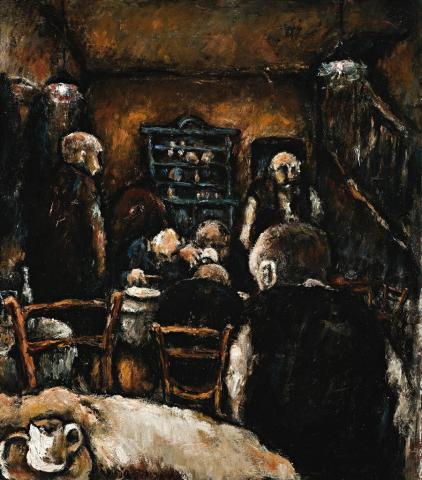THE GREEK CAFE, 1944
VIC O'CONNOR
oil on board
48.0 x 42.0 cm
Collection of L. Hawkins
Private collection, Melbourne
Lauraine Diggins Gallery, Melbourne (label attached verso)
Private collection, Perth, acquired from the above in 1987
Three Realist Artists, Myer Art Gallery, Melbourne, 16-25 July 1946, cat. 76, 20 gns
Noel Counihan, Vic O'Connor, James Wigley, Tye's Gallery, Melbourne, 6-16 October 1953, cat. 21 (as 'Greek Cafe', nfs)
V.G. O'Connor: Paintings, Victorian Artists' Society Galleries, Melbourne, 16-27 May 1955, cat. 1 (lent by L. Hawkins Esq.)
Selected Paintings by Vic O'Connor, 1939-83, Gryphon Gallery, Melbourne College of Advanced Education, Melbourne, 1-19 August 1983, cat. 8 (as 'Greek Cafe, 1944', nfs)
The migration of thousands of Greeks to Melbourne centred on the inner city, creating a Greek Precinct within Lonsdale, Swanston and Russell streets, home to restaurants, cafes and shops. Melbourne became the centre of the largest Greek-speaking colony in the world, second only to Athens and Thessalonica. While Vic O'Connor was drawn by the immigrant life on the streets of Fitzroy and Carlton, it was the smokey rooms of the Greek cafes of Lonsdale Street that exercised particular attraction. With a law degree and army service to distract him, O'Connor made a prominent start to his art career when he shared first prize in the 1941 Contemporary Art Society exhibition with Donald Friend. His winning painting, The Acrobats, received favourable notice in the Sydney press, and leading Sydney figures of the likes of Warwick Fairfax, Peter Bellew, and the ballerina Helen Kirsova bought his paintings. He met Noel Counihan and Yosl Bergner, becoming close friends, and joining them in the Anti-Fascist Exhibition of 1942. The catalogue preface opened with the words, 'Art is a social activity, and as such is organically united with the struggles and aspirations of humanity towards the ideals of democratic life', a view with which O'Connor was in complete accord.1 He had experienced the hardships of the Depression, worked as a young boy at the Victoria Market, joined the Communist Party, and became close to Melbourne's Jewish community. Together with Counihan and Bergner, O'Connor was a significant figure in the Social Realist movement and its concern about social injustice. They held their first major exhibition in 1946, 'Three Realist Artists' at the Myer Art Gallery, attracting considerable notice. Alan McCulloch in The Argus acknowledged it as 'one of the outstanding shows of the year.' Of O'Connor, McCulloch wrote, '[his] work is distinguished by a really beautiful sense of colour orchestration, ... it is always extremely sensitive.'2 The Greek Cafe, 1944 was drawn from visits to the Greek cafes, elevating the commonplace into a work of art. The emotional power of his colour, of darks enveloping the downtrodden upon which the light still shines, recalls Vincent van Gogh's early works, especially The Potato Eaters.3 There is a like compassion in the bent figures, anonymous, humble, but human. In the best of his art, like The Greek Cafe, O'Connor combines a painterly perception with a lawyer's acuity, touched by the conscience of a Social Realist. He regarded the painting so highly that it was included in exhibitions of 1953, 1955, and 1983 when Memory Holloway, The Age art critic, wrote 'the most intense of O'Connor's pictures are still those done between 1939 and 1944 - the facades of Fitzroy Street, St Kilda, the hostages and smoke filled rooms of a Lonsdale Greek cafe.'4
1. Quoted in Smith, B., Noel Counihan: Artist and Revolutionary, Oxford University Press, Melbourne, 1993, p. 172
2. McCulloch, A., 'Two Art Exhibitions', Argus, 16 July 1946, p. 6
3. Collection of the Rijksmuseum Vincent van Gogh, Amsterdam
4. Age, 10 August 1983, p. 13
DAVID THOMAS
